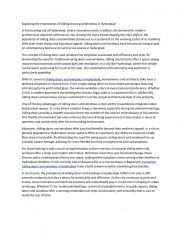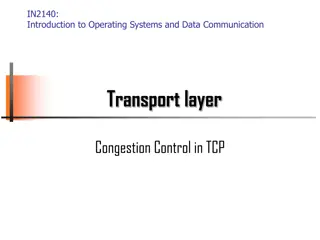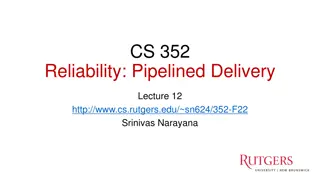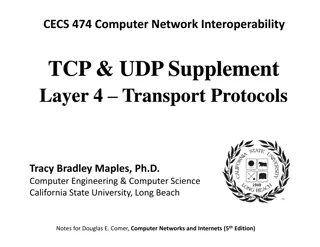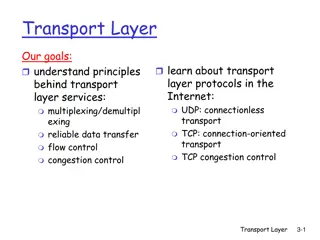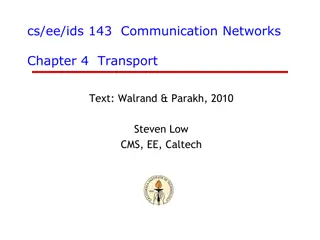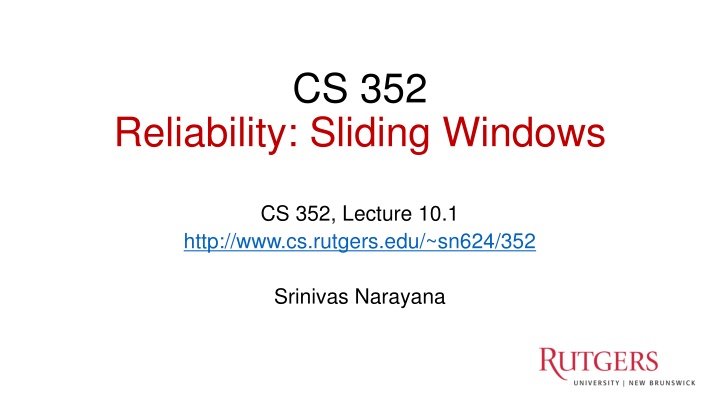
Network Reliability and Efficiency Through Pipelined Transmission
Explore the concepts of network reliability and efficient data transmission through pipelined protocols. Learn about guarantees provided by the transport layer, the importance of pipelined reliability, and how it enhances data throughput in networking environments.
Download Presentation

Please find below an Image/Link to download the presentation.
The content on the website is provided AS IS for your information and personal use only. It may not be sold, licensed, or shared on other websites without obtaining consent from the author. If you encounter any issues during the download, it is possible that the publisher has removed the file from their server.
You are allowed to download the files provided on this website for personal or commercial use, subject to the condition that they are used lawfully. All files are the property of their respective owners.
The content on the website is provided AS IS for your information and personal use only. It may not be sold, licensed, or shared on other websites without obtaining consent from the author.
E N D
Presentation Transcript
CS 352 Reliability: Sliding Windows CS 352, Lecture 10.1 http://www.cs.rutgers.edu/~sn624/352 Srinivas Narayana 1
Transport Application FTP HTTP HTTPS SMTP DNS Transport UDP TCP IP Network X.25 802.11 ATM Host-to-Net
Modularity through layering Apps: useful user-level functions HTTP FTP NV TFTP TCP UDP Transport: provide guarantees to apps IP Network: best-effort global pkt delivery Ether ATM WiFi Link: best-effort local pkt delivery
How do apps get perf guarantees? The network core provides no guarantees on packet delivery Transport software on the endpoint oversees implementing guarantees on top of a best-effort network Three important kinds of guarantees Reliability Ordered delivery Resource sharing in the network core Transmission Control Protocol (TCP)
Review: Stop-and-Wait Reliability Stop and wait: sender waits for an ACK/RTO before sending another packet Receiver Sender Suppose no packets are dropped RTT = RTO = 100 milliseconds Packet size: 12 Kbit (1 K = 103) Link rate: 12 Mbit/s (1 M = 106) RTT Rate of data transmission? one packet per RTT = 12Kbits / 100ms = 120 Kbit/s RTO 120 Kilobit/s == 1% of link rate
Making reliable transmissions efficient Terminology: unACKed data / packets in flight Data that has been sent, but not known (by the sender) to be received With just one packet in flight, the data rate is limited by the packet delay (RTT) rather than available bandwidth (link rate) Larger the delay, slower the data rate, regardless of link rate Idea: Keep many packets in flight! More packets in flight improves throughput We say such protocols implement pipelined reliability
Why does pipelined reliability help? Suppose sender has multiple, in-flight (yet-to-be-acknowledged) packets New packets transmitted concurrently with in-flight packets Packets and ACKs (of prior packets) are concurrently transmitted More data and ACKs transmitted within the same duration 7
Tracking packets in flight Receiver Sender If there are N packets in flight, throughput improves by N times relative to stop-and- wait. Stop and wait: send 1 packet per RTT Pipelined: send N packets per RTT RTT We term the in-flight data the window We term the amount of in-flight data the window size RTO
Window Window: Sequence numbers of in-flight data Window size: The amount of in-flight data (unACKed) Sequence numbers restart from 0 beyond a point (finite space on header) Window size = 3 Sender s point of view: 0 1 0 3 1 4 2 5 7 6 0 7 1 6 2 Last seq # known to be received at receiver (ACK ed) Last sequence # sent 3 5 4 Transmissions later in time
Sliding window (sender side) Suppose sequence number 2 is acknowledged by the receiver Sender can transmit sequence # 5 The window slides forward Window size = 3 Sender s point of view: 0 1 0 3 1 4 2 5 7 6 0 7 1 6 2 Last seq # known to be received at receiver (ACK ed) Last sequence # sent 3 5 4
Sliding window (sender side) Suppose sequence number 2 is acknowledged by the receiver Sender can transmit sequence # 5 The window slides forward Window size = 3 Sender s point of view: 0 1 0 3 1 4 2 5 7 6 0 7 1 6 2 Last seq # known to be received at receiver (ACK ed) Last sequence # sent 3 5 4
Sliding window (receiver side) Window of in-flight packets can look different between sender and the receiver: receiver has more recent info of in-flight Receiver only accepts sequence #s as allowed by the current receiver window Window size = 3 Receiver will not accept this seq #. Packet dropped Receiver s point of view: 1 0 3 1 4 2 5 7 6 0 Last seq # received and ACK ed by receiver Highest sequence # accepted
Summary of sliding windows Sender and receiver can keep several packets of in-flight data Book-keep the sequence numbers using the window Windows slide forward as packets are ACKed (at receiver) and ACKs are received (at sender) Common case: Improve throughput by sending and ACKing more packets in the same duration Key challenge: how should the sender and receiver collaboratively track the packets that must be retransmitted?
CS 352 Making Retransmissions Efficient CS 352, Lecture 10.2 http://www.cs.rutgers.edu/~sn624/352 Srinivas Narayana 16
Pipelined Reliability Receiver Sender If there are N packets in flight, throughput improves by N times relative to stop-and-wait. Stop and wait: send 1 packet per RTT Pipelined: send N packets per RTT RTT Q1: how should sender efficiently identify which pkts were dropped and (hence) retransmitted? Q2: how much data to keep in flight (i.e., what is N?) to reduce drops/retransmits? RTO
Q1. Identifying the Dropped Packets
Q1: Identifying dropped packets Receiver Sender Suppose 4 packets were sent, but one was dropped. How does sender know which one(s) were dropped? Recall: Receiver writes sequence numbers on the ACK Sender infers which bytes were received successfully using the ACK #s RTT Should this ACK exist ??? Q1.1: Should receivers ACK subsequent packets upon detecting data loss? Q1.2: If so, what sequence number should receiver put on the ACK? RTO
Receiver strategies upon packet loss Receiver Sender ACK subsequent pkts? 1 2 No Yes 3 4 Go-back-N Selective Repeat What seq # on ACK? 5 Seq # ranges received so far Selective ACK TCP s default Last pkt in order Cumulative ACK
Sliding Window with Go Back N When the receiver notices a missing or erroneous frame: It simply discards all frames with greater sequence numbers The receiver will send no ACK The sender will eventually time out and retransmit all the frames in its sending window
Go back N RTO Sender Maximum window size = 8 0 1 2 3 4 2 3 4 5 6 Receiver Maximum window size = 8 0 1 2 3 4 5 6 E D D Discarded by receiver Frame with error Time
Go back N Go Back N can recover from erroneous or missing frames. But it is wasteful. If there are errors, the sender will spend time and network bandwidth retransmitting data the receiver has already seen.
Selective repeat with cumulative ACK Idea: sender should only retransmit dropped/corrupted segments. The receiver stores all the correct frames that arrive following the bad one. (Note that the receiver requires a memory buffer for each sequence number in its receiver window.) When the receiver notices a skipped sequence number, it keeps acknowledging the first in-order sequence number it wants to receive. This is what we mean by cumulative ACK. When the sender times out waiting for an acknowledgement, it just retransmits the first unacknowledged packet, not all its successors. Note that the RTO applies independently to each sequence #
Selective repeat with cumulative ACK RTO Sender Maximum window size = 8 0 1 2 3 4 2 5 6 Receiver Maximum window size = 8 0 1 3 4 2 5 6 E Buffered by receiver Frame with error Time
Selective repeat with selective ACK RTO Sender Maximum window size = 8 0 1 2 3 4 2 5 6 Receiver Maximum window size = 8 0 1 3 4 2 5 6 E Buffered by receiver Frame with error Time
TCP: Cumulative & Selective ACKs Receiver Sender Sender retransmits the seq #s it thinks aren t received successfully yet Pros & cons: selective vs. cumulative ACKs Precision of info available to sender Redundancy of retransmissions Packet header space Complexity (and bugs) in transport software On modern OSes, TCP uses selective ACKs by default 1 2 3 4 2 3 4 5 5
Memory Buffers in the Transport Layer
Receiver-side sockets need memory buffers Since TCP uses selective repeat, the receiver must buffer data that is received out of order: e.g., hold packets so that only the holes (due to drops) need to be filled in later, without having to retransmit packets that were received successfully Apps read from the receive-side socket buffer when you do a recv() call. Even if data reliably received in order, applications may not always read the data immediately What if you invoked recv() in your socket program infrequently (or never)? For the same reason, UDP sockets also have buffers
Sender-side sockets need memory buffers The possibility of packet retransmission in the future means that data can t be immediately discarded from the sender once transmitted. Transport layer must wait for ACK of a piece of data before reclaiming the memory for that data.
Q2. How much data to keep in flight?
Q2: How much data to keep in flight? Challenging question! We want to increase throughput. But: The receiving app must keep up: otherwise, receiver socket buffer will fill up. Once full, subsequent packets are dropped. Even if receiving app is fast, there must be sufficient buffering for selective repeat, if some data is dropped/corrupted The network path must be able to keep up. We don t want window to be so large that pkts dropped anyway Challenge: The sender must figure out where the bottleneck is: receiving app? Socket buffer? A link along the network path? Flow control and congestion control
Inspecting TCP stack parameters A small demo
Info on (tuning) TCP stack parameters https://www.ibm.com/support/knowledgecenter/linuxonibm/liaag/ wkvm/wkvm_c_tune_tcpip.htm https://cloud.google.com/solutions/tcp-optimization-for-network- performance-in-gcp-and-hybrid



